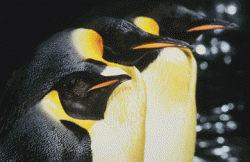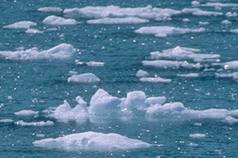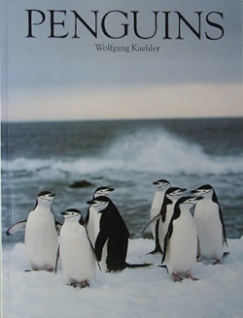Category Archives: dog
Penguins (Flightless animal..!!)
google.load(“elements”, “1”, {packages: “transliteration”});
Penguins are generally divided into 6 groups that contain 15-18 species (depending on which “expert” you listen to). There is some disagreement on the number of species, because the Fairy, Gentoo, and Rockhopper species have been divided into subspecies.
 Largest of the Penguins
Largest of the Penguins
* Emperor Penguin —————————- Aptenodytes forsteri
* King Penguin ——————————– Aptenodytes patagonicus
Brush tailed Penguins
* Adelie Penguin —————————– Pygoscelis adeliae
* Chinstrap Penguin ————————– Pygoscelis Antarctica
* Gentoo Penguin —————————- Pygoscelis papua
(although several of the books I read said the Gentoo had subspecies — I
couldn’t find the name(s) listed anywhere.)
Warm Weather Penguins
* Magellanic Penguin ————————– Spheniscus magellanicus
* Peruvian (or Humboldt) Penguin ————- Spheniscus humboldti
* Blackfoot (or Jackass) Penguin ————– Spheniscus demersus
* Galapagos Penguin ————————– Spheniscus mendiculus
Crested Penguins
* Macaroni Penguin ————————— Eudyptes chrysolophus
* Rockhoper Penguin ————————- Eudyptes crestatus
* Royal Penguin ————————— Eudyptes schlegeli
(some say is a subspecies of the Rockhopper)
* Erect-Crested Penguin ———————- Eudyptes sclateri
* Snares Island Crested Penguin ———– Eudyptes robustus
(some say is a subspecies of the Erect-Crested)
* Fiordland Penguin ————————— Eudyptes pachyrhynchus
Yellow-eyed Penguin (in a class b
y itself)
* Yellow-eyed Penguin ———————– Megadyptes antipodes
Fairy Penguin (in a class by itself — with its subspecies)
* Little Blue (or Fairy) Penguin —————- Eudyptula minor
* White Flippered Penguin —————– Eudyptula albosignata (One book mentioned four subspecies, but only named this one.
Thanks to Mak Thorpe for providing the Latin name.)

Habitat
Even though most people think of Antarctica when they think of penguins, actually only two species live on the Antarctic continent (the Adelie and the Emperor). The other species range in habitat from the islands near the Antarctic circle, to the shores of South America, South Africa, Australia, New Zealand, and the Galapagos Islands.
Some species of penguins live 75% of their lives at sea, coming to shore only to breed and molt. Migratory penguins will spend 3-5 months at sea, before coming to shore. Although they do rest on ice floes. Very few details are known about the penguin’s life in the sea.
Preditors Penguins have no large land predators, which is probably why they have little fear of people. The Yellow-eyed penguin is the exception, they are very shy and reclusive. (And also in danger of extinction. It is estimated that there are less than 10,000 left in the world.)
In the sea, penguins are preyed on by killer whales, leopard seals, sea lions, sharks and (according to one book I read) octopus (octopi?).

In Motion Penguins are great swimmers, with speeds reaching 15 MPH. The Emperor penguin can dive to a depth of 900 feet and stay under for 20 minutes. On land the penguin is not so graceful, their short legs give them their distinctive waddle. They also get around by “tobogganing”, which means they flop down on their belly and kick with their feet and flippers over the snow and ice.
Physical Characteristics
Penguins are extremely specialized birds. Totally adapted to the life they lead. Their wings have become flippers, and their feathers have become unlike the feathers of any other type of bird. The feathers are very dense, approximately 70 feathers per square inch. They are shiny, long and stiff. They are somewhat curved and overlapping (like fish scales, or the tiles on a roof). This design helps keep the penguin waterproof. The penguin also keep their feathers well oiled with frequent preening and an oil gland at the base of the tail. Once a year, after breeding, the penguins molt (that is replace the old worn out feathers with new ones). Since the penguins are not waterproof while they are molting, they do not go to sea, and do not eat, during this time. Molting can take 30 days and a penguin may lose as much as 30% of their body weight in the process.
One book mentioned that (since they spend most of their time at sea) penguins drink salt water. They have special glands that remove the salt. It is then excreted as a liquid and drips down the grooves on the sides of the penguins beak.
Cold weather (climat
e) penguins are well insulated with their thick blubber and feathers. In fact sometimes they become over heated (even the antarctic breeds), especially the dark feathered chicks. To cool off the penguins will pant and fluff up their feathers, to promote heat loss.
Warm climate penguins have exposed areas of pinkish skin on their faces and legs and feet. This helps them keep cool. If the weather is too hot, they will spend most of their time in underground burrows or in the sea, where the cold currents keep them cool.

Prehistoric
Penguins are one of the oldest kinds of birds. It is believed that penguins have been around for 50 million years. The first penguin fossil was discovered in New Zealand about 1849 and is now kept at the British Museum of Natural History. Since that time the fossils of many, now extinct, species have been discovered. Most of the extinct species were about the same size as the species living today. However two species were enormous, standing over 5 feet tall and weighing as much as 300 lbs.
Penguin fossils were discovered in Australia about 1888, but they were not reconized as being from penguins until 1957. Fossils were found in South America about 1891 and on Seymour Island, Antarctica in 1903 . All of the penguin fossils found in South America have been found in the southern part of Argentina and they all come from the same age (about 35 million years ago). Penguin fossils were not found in South Africa until 1970.

History of the Name
The name “penguin” was originally given to a bird that is now called the Great Auk (pictured at left). It was a large flightless bird with black and white markings. It was native to the North Atlantic ocean. (The great Auk has been extinct since 1844). When adventurers started exploring the southern oc
eans, they discovered more birds that resembled the northern “penguin” and called them penguins too. (As we still do today.)
Although it is not documented, it is believed that Portuguese sailors discovered the South African Blackfooted penguin as early as the 1480’s. Ferdinand Magellan is credited with the first documented discovery of penguins, around 1500. The Megellanic penguin is named after him (actually, one book said the penguin is named after the Straits of Magellan, where they are found, not after the explorer).
jOin my pagE..
http://www.facebook.com/pages/manage/#!/pages/Aamir-Maqsood/103561353010444






